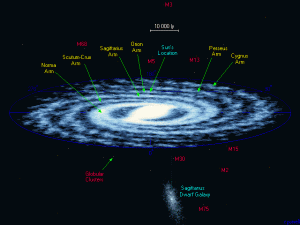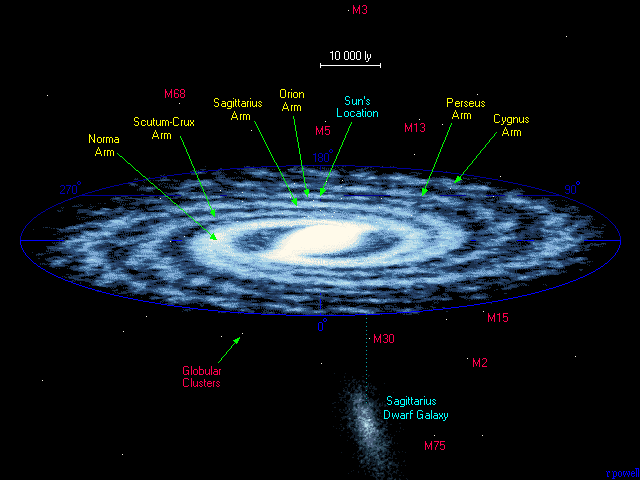Formation:
–Orbits of stars, ages of stars, the metal contents in stars, and the amount of gas and dust are all different
- Current theory suggests that the Galaxy formed from an enormous cloud of gas (the Protogalactic Cloud)
- The halo and the first generations of stars formed as this cloud contracted under the influence of gravity
–The first generations of stars are metal-poor
- Over many generations of star formation, the cloud slowly flatten out into a disk and its rotation sped up
–Gas and dust collected in the disk
–Gas is enriched with heavy elements
Suns location in the Galaxy
- Harlow Shapley assumed that globular clusters distribute evenly around the centre of the Galaxy
–Distances to globular clusters can be obtained by observing Cepheids and RR Lyrae stars in the clusters
–from the distribution of the globular clusters, he located the centre of the Galaxy at a distance of 15 kpc from the Sun
- today, we know that globular clusters form a spherical distribution centered around a point in the constellation Sagittarius, 8 kpc from the Sun
- •They found that the Sun is travelling at a speed of 220 km/s in a nearly circular path around the galactic centre. The radius of the Sun’s orbit is about 28,000 ly
Galactic Disk
- About 100,000 ly across and 1000 ly thick
- Four major spiral arms and several shorter arm segments
- Mixture of young and old, metal-rich stars, gas and dust
- Sites of ongoing star formation along the spiral arms
- Gas and stars move in roughly circular orbits around the centre
Galactic Bulge
- A flattened sphere of stars about 10,000 ly in diameter centered at the nucleus
- Contains primarily old stars except near the Galactic Centre
- Density of stars, gas and dust is higher within the bulge than in the disk
- Appears reddish in colour because of many red giant and supergiant stars
Galactic Halo
- The spherical distribution of globular clusters defines the halo of the Galaxy
- Diameter about 400,000 ly
- The major components include isolated old, metal-poor stars and about 200 globular clusters
- Contains almost no gas and dust, and no recent star formation
Interstellar Dust
- Early efforts to find out where the sun is located within our Milky Way Galaxy were hindered by the then unknown interstellar dust
–Dust dims starlight by absorbing and scattering photons
–Interstellar dust concentrates in the plane of the Galaxy
–Result is one cannot see very far in visible light (and UV), and what one sees is interpreted incorrectly
- Stars appear dimmer than they really are, so determining distances that way would be wrong (too large or too small?)
Determining Galactic Mass
- If an object orbits a huge mass its orbital speed has to be very high (otherwise it will fall toward the mass)
- Conversely, if you can measure the orbital speed, you can use it to determine the mass of the object it is orbiting
Spiral Arms
- The spiral structure in the disk was discovered when radio telescopes were used to map the disk
–This is because radio telescopes are sensitive to radio waves, which has longer wavelengths and are not absorbed by interstellar dust
- Since the spiral arms contains a lot of gas clouds (and young blue stars), and since gas clouds emits strongly in radio wave, radio mapping proves to be very useful
–Interstellar gas cloud contains mostly neutral Hydrogen (HI)
Radio Observations: Neutral H atoms emit a strong line at 21cm
–Spin in the same direction, the atom as a whole is at a higher energy level
–Spin in opposite direction, the atom is at a lower energy level
HI line: when the atom changes from the high-energy level to the low-energy level, it emits a photon at the 21cm wavelength
The Black Hole
- The stellar remnant of a very massive star (> 8 times the mass of the sun)
- When such a massive star comes to the end of its life, it dies with a spectacular explosion called a supernova
- 90% of the star’s atmosphere (envelope) gets expelled into interstellar space, leaving an extremely dense but tiny core behind
- This core is so dense that it collapses under its own weight. There is no known force that can stop this process, and the whole core collapses into a point in space — a black hole
- If an object comes very close to a black hole, the gravitational attraction may be too strong for it to escape
- At a certain radius from the black hole, called the Schwartzchild Radius, an object needs to have the speed of light in order to escape
–e.g., a black hole that has the mass of the sun would have a Schwartzchild radius of 3 km
- Within the Schwartzchild radius, even light cannot escape — hence the name
- Known to reside in the nuclei of many galaxies
The Galactic Nucleus
- Heavily obscured by dust
- Density of stars a million times higher than in the Sun’s neighbourhood
Galactic Recycling
- This gas merges with the gas of the interstellar medium and gets incorporated into the next generation of star formation – a recycling process
- Therefore, younger stars have higher % of metal compared with older stars


